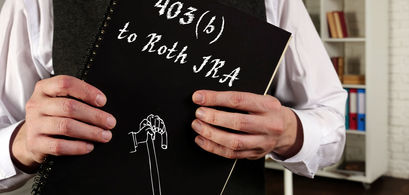Back in 2006, the Bush Administration created a new way to fund a 403(b) plan: the Roth 403(b). In this article, we're going to discuss the benefits of a Roth 403(b), along with the rules of these plans including withdrawals, distributions, contributions, and income taxes.
Background of the Roth 403(b)
Starting in January 2006, operators of traditional 403(b) plans could offer their employees what's being called a Roth 403(b) plan. In essence, this is the offering of "Roth" treatment for funds going into a 403(b) account.
A Roth 403(b) combines the contribution features of 403(b) plans, with the tax-free growth advantage of Roth IRAs. Employees currently offered the ability to fund their retirement plans using 403(b) accounts may now be offered the option of participating in a Roth 403(b). With this new plan, participants will never have to pay federal income taxes on the growth portion of the account, or their contributions, when they withdraw the money.
Requirements
Roth 403(b) plans have very few administrative requirements. Employers have the opportunity to consolidate a variety of retirement funds into what are called Employer Retirement Savings Accounts, or ERSAs. These ERSAs will be available to all employers that meet several simple qualifications.
As previously mentioned, the proposal becomes effective for the years beginning after December 31, 2005. In most situations, that translated into January 1, 2006. Finally, retirement money placed into a Roth 403(b) has to be kept in an account that is separate from other funding.
Benefits
Many employees currently participating in a 403(b) plan at work will be offered the opportunity to participate in a Roth 403(b). For those people, the question they are going to be asking themselves is this: Should I fund a Roth 403(b) or stick with my existing 403(b) plan?
The answer to that question has to do with each plan's income tax treatment of contributions and withdrawals, and what they believe will be their income tax bracket in retirement. By making before-tax contributions to a traditional 403(b) plan, they're reducing their current tax liability. With a Roth 403(b), they will be making after-tax contributions:
While before-tax contributions act to reduce taxable income today, accountholders will pay income taxes on the contributions and earnings when they're distributed in retirement.
Roth 403(b) contributions won't reduce taxable income right now. But these contributions, and the earnings on them, are tax-free at retirement; as long as the accountholder is at least age 591/2, and their Roth 403(b) account is at least five years old.
If an individual believes they're in a higher tax bracket today than they will be in retirement, then sticking with a 403(b) plan might be the best option. If they think their tax bracket will stay the same or increase when retired, then a Roth 403(b) is probably the best choice.
Roth Treatment of 403(b) Contributions
Plan administrators can elect to make available to their employees Roth treatment of contributions to retirement savings plans such as a 403(b) plan. The intention of the change would be to help consolidate all of the retirement accounts that permit employees to make after-tax contributions to a retirement savings account.
Contribution Limits
ESRAs need to follow the rules previously outlined for 401(k) plans, with additional simplifications. We've already talked about Roth 401(k) plans in a previous article. Employees can defer, or contribute, up to $19,500 in wages annually in 2020 and 2021. Just like other retirement plans, there is an additional catch-up contribution of $6,500 for employees 50 and older in 2020 and 2021. The maximum total contribution limit, which also includes employer contributions, is the lesser of $57,000 or 100% of the employee's compensation in 2020 and $58,000 in 2021.
For more information on the limits for the years 2022 and beyond, take a look at our article on 403(b) Contribution Rules.
Note: Updated limits are generally available in mid to late October.
Withdrawals and Distributions
Like its predecessors, the Roth 403(b) was established as a retirement plan. That means the IRS frowns on early withdrawals that occur before age 59 1/2. Hardship or other types of withdrawals are subject to the same 403(b) rules and penalties that are currently on the books. The Roth 403(b) minimum distribution rules are also similar to 403(b) withdrawal plans. This means accountholders will need to begin taking mandatory distributions when they reach age 70 1/2.
Taxes on Distributions and Contributions
The tax liabilities associated with employee contributions and distributions from an ERSA would be the same as the plans the ESRA is replacing. The employee could fund an ERSA with pre-tax monies, after-tax contributions, or Roth contributions. The exact type will depend on the plan's design.
Distributions of Roth 403(b) (after-tax) contributions, and the earnings on those funds, would not be included in income for tax purposes. Other distributions, such as those made on a before-tax basis, would be included as taxable income. The rules are similar to those of existing plans, but the introduction of the "Roth" concept, and its benefits, add to the plan's overall attractiveness as a retirement fund.
Income Tax Rules
The income tax guidelines that apply to a Roth 403(b) are fairly easy to remember using these two rules of thumb:
This type of plan allows participants to put money into their account on an after-tax basis, just like a Roth IRA. And just like a Roth IRA, the distributions from a Roth 403(b) are free from federal income taxes.
If an employer contributes to a Roth 403(b), such as the case when employers match funds, those contributions have gone into an account on a before-tax basis (the accountholder never paid income taxes on the employer's contributions). Therefore, the portion of the Roth 403(b) funding that comes from employer contributions is subject to federal income taxes upon withdrawal.
For this reason, an employer's matching contributions to a Roth 403(b) will oftentimes be placed in a traditional 403(b) account.




